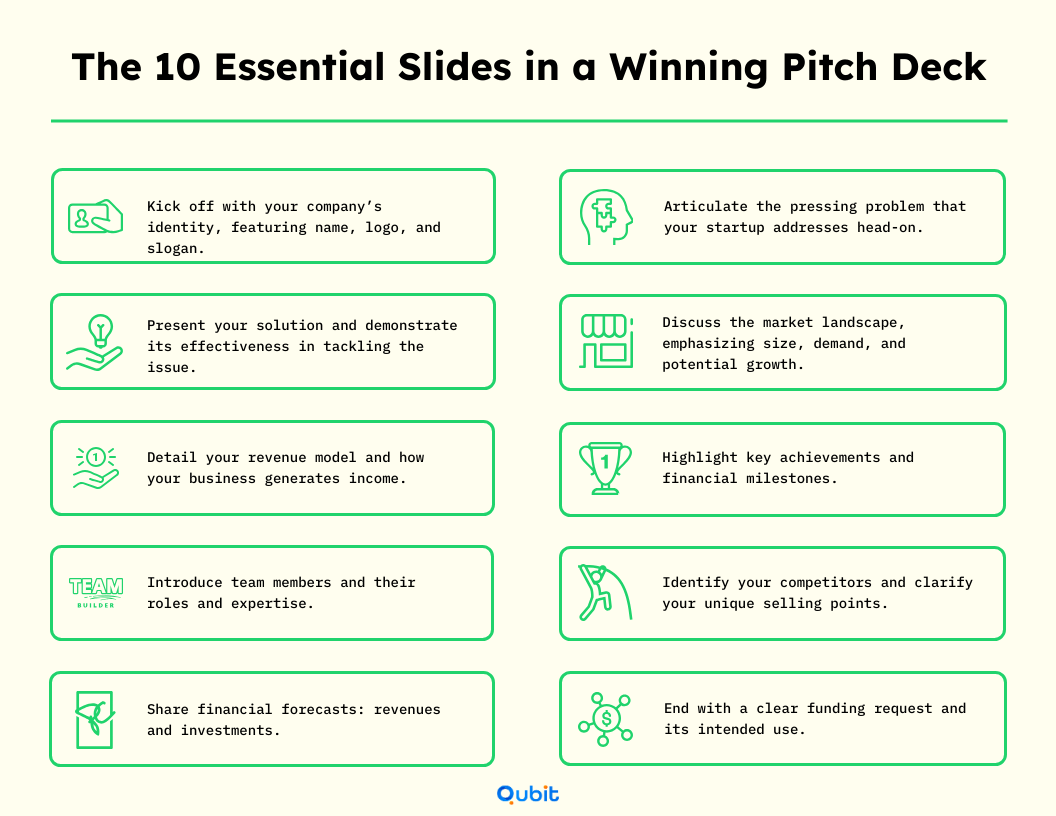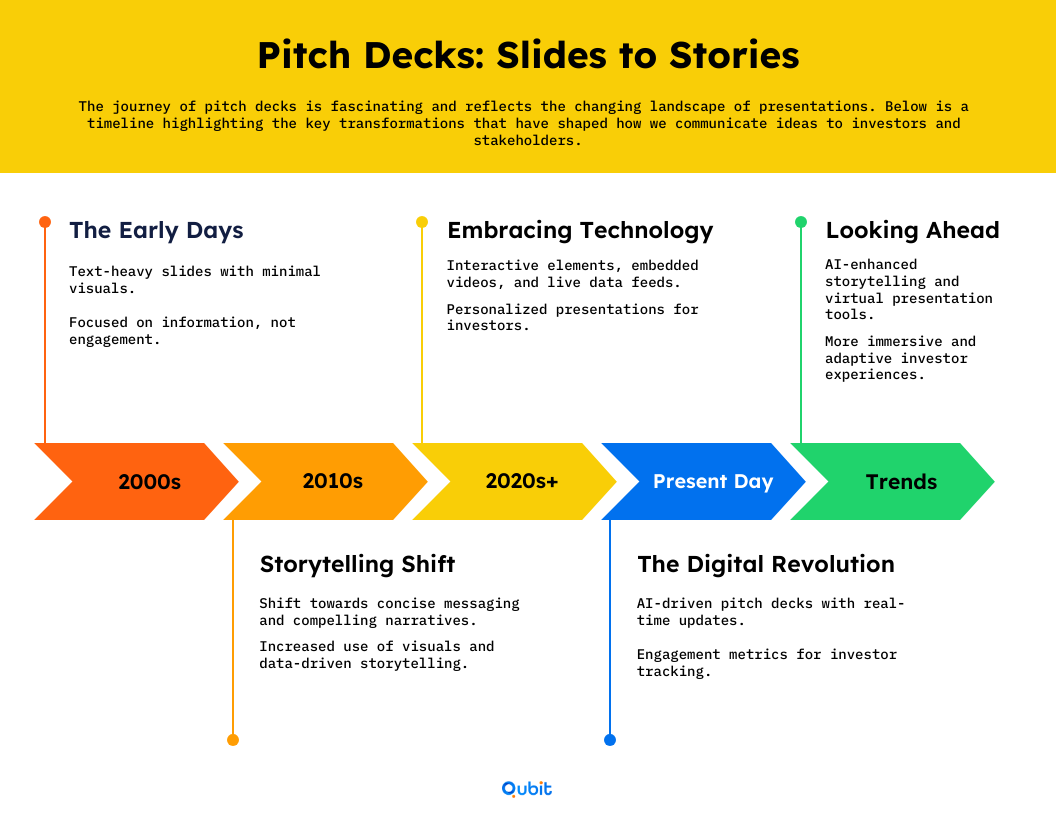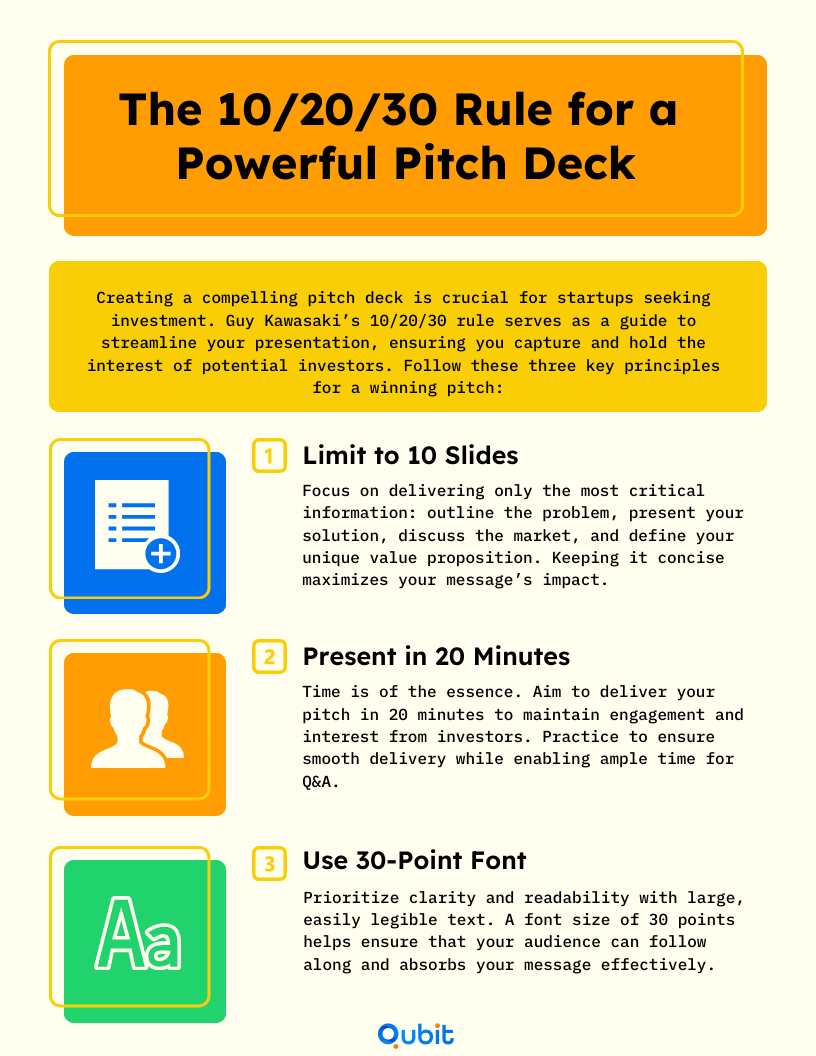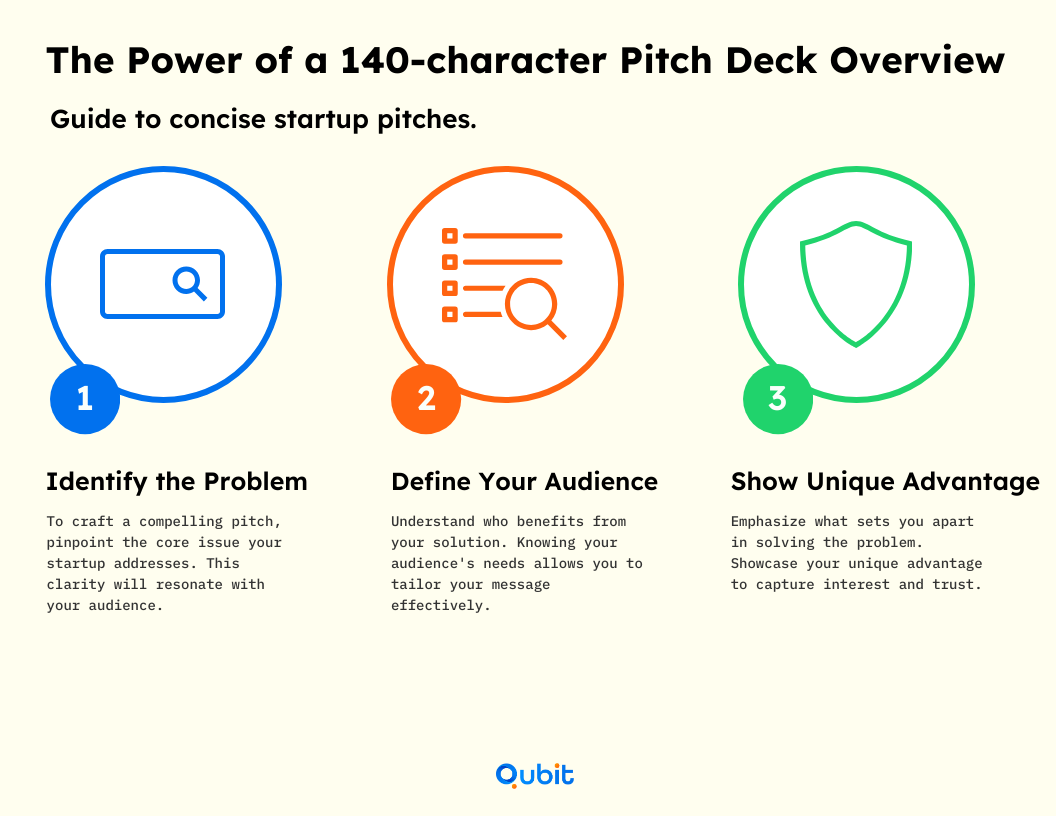In a world where investor attention spans less than three minutes per pitch deck on average, standing out is no longer optional—it’s imperative. Pitch deck design has evolved from static slides to dynamic narratives that fuse compelling visuals with data-driven storytelling. But how do you strike the right balance between clarity, minimalism, and interactivity?
Visual storytelling serves as a cornerstone for creating impactful presentations, enabling startups and businesses to convey complex ideas with ease. Without prioritizing clean designs and interactive elements, a pitch deck fails to captivate investors and enhance engagement.
Foundations of Visual Pitch Deck Design
Definition and Evolution of Pitch Decks
A pitch deck serves as a concise presentation that communicates the core value proposition of a business to potential investors. Over the years, pitch deck design has evolved significantly, transitioning from text-heavy slides to visually engaging layouts. Today’s startups prioritize clarity and storytelling, ensuring their presentation flows seamlessly and captures investor interest.
Modern slide deck design embraces clean aesthetics, leveraging visuals, graphs, and minimal text to convey ideas effectively. This transformation aligns with the need for brevity and focus in high-stakes investor meetings.
Investor Attention Metrics and Optimal Slide Count
You must decide on the optimal slide count, tailored to the investor of your type. Research reveals that investors dedicate just 10 seconds to each slide on average. This metric underscores the importance of designing concise and impactful slides. To enhance engagement, focus on one-message-per-slide and limit text to 30-40 words.
Optimal slide count ranges between 10 and 15, balancing brevity with comprehensiveness. Understanding essential pitch deck components ensures your visuals align cohesively with the narrative, strengthening investor appeal. For businesses, the key to a lasting impression during their pitch is simplifying content combined with emphasizing key insights
Adopting these strategies when you create a pitch deck can dramatically increase its effectiveness, maximizing investor interest while fostering clarity.
Visual Storytelling Techniques in Pitch Deck Design
Harnessing the power of visual storytelling can transform your pitch deck design into a compelling narrative that resonates with investors. By employing icons, infographics, and minimalist text, you simplify complex data while highlighting key metrics and narratives effectively. Visual elements not only enhance clarity but also make your presentation memorable.
A successful pitch deck design starts with a focus on simplicity. Implementing a one-primary-message-per-slide approach ensures that your audience remains engaged and avoids being overwhelmed by excessive information. Pair this strategy with graphics like charts, diagrams, and infographics to illustrate data points effectively. For instance, incorporating icons to represent market trends or customer demographics can make abstract concepts more relatable.
To achieve the best pitch deck designs, many founders turn to tools that streamline slide deck creation. A user-friendly design tool like Canva allows you to craft visually appealing slides with ease. Such tools offer pre-designed templates, making it simple to integrate striking visuals that align with your brand.
Additionally, visualizing data effectively strengthens your pitch deck, ensuring that even complex metrics are accessible to investors. By limiting text and prioritizing visual elements, your presentation remains focused, clear, and impactful. This approach not only enhances understanding but also leaves a lasting impression, paving the way for investor confidence.
Interactive Slide Deck Design Strategies
Integration of Interactive Elements
Interactive elements are transforming pitch deck design, offering dynamic ways to captivate investors. Incorporating multimedia, such as videos or animations, can effectively communicate complex ideas in seconds. These elements engage audiences visually while breaking monotony, ensuring key messages resonate. For example, embedding explainer videos can showcase product capabilities more vividly than text alone.
Real-time collaboration tools are another game-changer for modern pitch deck design. Platforms like Google Slides or Figma empower teams to refine content in real time, fostering seamless updates and consistent messaging. This approach minimizes errors and ensures presentations reflect the latest data, especially in fast-paced industries.
However, clarity must remain a priority. Overloading a deck with too many interactive features can detract from the narrative. Avoiding design mistakes ensures that the deck maintains balance and keeps investors focused on core objectives. To explore strategies for avoiding design mistakes, check out our detailed insights.
Utilizing AI-Powered Tools in Design
AI-powered tools are revolutionizing professional pitch deck design. These platforms streamline the creative process, enabling teams to focus on storytelling rather than formatting. For instance, an AI-powered tool like Beautiful.ai optimizes slide layouts automatically, ensuring visual consistency and reducing manual effort.
AI also enhances customization, tailoring slide designs to specific audiences or industries. This personalization increases relevance, making presentations more impactful. Similarly, AI-driven feedback loops can analyze audience engagement metrics, offering insights to improve future iterations.
By blending interactive features with minimalist aesthetics, modern pitch deck design achieves sophistication without sacrificing functionality.
Minimalism and Clarity Enhancing Slide Content
In the world of pitch deck design, simplicity often speaks louder than complexity. Minimalist design principles prioritize clean layouts, ample white space, and a focus on one central message per slide. This approach ensures that your audience remains engaged without being overwhelmed.
Minimalist Design Trend
The minimalist trend in pitch deck design revolves around cutting down visual clutter. By using consistent color palettes and white space strategically, you can direct attention to the core content instead of distracting elements. For example, employing bullet points instead of lengthy paragraphs simplifies information delivery while maintaining clarity.
Additionally, leveraging pitch deck templates can aid in creating cohesive designs. These templates provide pre-designed layouts that align with branding while keeping the slides polished and professional. Integrating them into your deck ensures uniformity in style, making your presentation visually appealing and easy to follow.
Consistent Branding and Optimal Text Limits
Consistency in branding is another hallmark of effective pitch deck design. Using uniform fonts, colors, and logos across all slides reinforces brand identity, leaving a lasting impression on your audience. For typography, selecting the best fonts for pitch deck presentations—such as sans-serif options for readability—enhances the overall aesthetic.
Moreover, limiting text to concise phrases ensures that the deck doesn’t overwhelm viewers. This aligns with the principle of maintaining focus on a single idea per slide. A focus on critical slides further demonstrates how structured content deepens investor understanding.
To master how to create a pitch deck that captivates, implement uncluttered designs, uniform branding, and concise messaging—each slide should tell its own story while contributing to the larger narrative.
Optimizing Pitch Deck Layout with Empirical Data
When it comes to pitch deck design, data-driven decisions make all the difference. Investors typically spend just 3 minutes and 44 seconds reviewing an entire pitch deck, with only 10 seconds allocated per slide. These statistics underscore the need for concise, visually engaging content that communicates key messages effectively.
Data Integration for Enhanced Engagement
Empirical data offers valuable insights that can refine your pitch deck’s structure. Here are actionable ways to leverage these metrics:
- Focus on the Executive Summary: Investors often prioritize this section, making it essential to create a compelling overview. Concise messaging paired with impactful visuals ensures your core value proposition stands out. To learn more, explore the importance of a unique value proposition, where messaging and design work hand-in-hand.
- Limit Slide Content: Too much information overwhelms the reader. Utilize clear headings, bullet points, and strategically placed graphics to create slides that are easy to digest in under 10 seconds.
- Prioritize Visual Representation: Incorporate charts, infographics, and other visual aids to distill complex data into digestible content. Effective graphic design pitch deck elements not only improve readability but also enhance aesthetic appeal.
Case Studies and Successful Pitch Deck Examples
Learning from successful pitch deck examples provides invaluable insights into effective design and presentation strategies. Companies like Airbnb, Dropbox, and Apple have set benchmarks in pitch deck design, showcasing how clarity and visual consistency can captivate investors. These examples demonstrate that a good pitch deck is not merely about aesthetics but about crafting a compelling narrative that communicates value.
Airbnb’s pitch deck is an excellent example of simplicity paired with precision. It clearly defines the problem, presents the solution, and highlights market potential—all within a concise and visually appealing framework. With its focus on key metrics and straightforward design, Airbnb’s deck stands as a model of how to create a pitch deck that resonates with investors.
Dropbox’s pitch deck, on the other hand, emphasizes storytelling. Through relatable scenarios and engaging visuals, it builds a narrative around the user experience. This approach underscores the importance of connecting emotionally with investors while presenting a scalable business model.
Apple’s pitch deck for the iPhone launch is a masterclass in leveraging brand identity. Its sleek design and focused messaging reflect Apple’s core values, proving that consistency in visual design can reinforce trust and credibility.
Drawing lessons from successful startups can significantly bolster your pitch deck design. By analyzing these examples, you can refine your approach, ensuring your deck effectively communicates your value proposition.
Creating impactful presentations is the cornerstone of successful pitch decks, ensuring that every slide captures investor attention.
Interactive Tools and Strategies for Real-Time Collaboration
Collaborative pitch deck design has transformed significantly with interactive tools and strategies that emphasize real-time teamwork. By utilizing advanced solutions, teams can streamline the creative process, ensuring that ideas are shared and refined efficiently.
For example, teams often use a cloud-based tool like Google Slides for seamless collaboration on pitch decks, allowing contributors to edit simultaneously and provide immediate feedback. This enhances the overall workflow and fosters a more dynamic design environment.
Key Strategies for Enhanced Collaboration
- Real-Time Input
Platforms equipped with live editing features enable team members to contribute directly to the pitch deck design. This real-time collaboration ensures that everyone’s input is integrated promptly, reducing delays caused by back-and-forth communication. - AI-Powered Design Tools
Utilizing the best pitch deck software equipped with AI capabilities can streamline layout creation. These tools suggest design adjustments and optimize visual elements, making the process more efficient for professional pitch deck design. - Continuous Feedback Loops
Iterative feedback mechanisms are crucial. Incorporating multimedia elements, such as embedded videos or infographics, allows teams to refine and elevate designs based on collective reviews.
Crafting a compelling pitch deck is just the beginning. At Qubit Capital, we provide comprehensive startup fundraising services to guide you through every stage of your fundraising journey.
Effective Slide Structuring and Content Organization
Creating a compelling pitch deck design is often about finding the balance between clarity and persuasion. To achieve this, structuring slides effectively is key. Adopting a one-message-per-slide approach ensures that each slide communicates a single, focused idea.
This method prevents information overload and enhances audience retention. Coupling this with optimal text limits—keeping content concise and to the point—can make your presentation more digestible.
White space also plays a significant role in presentation deck design. It provides visual breathing room, helping to highlight essential elements without overwhelming viewers. By strategically using white space, presenters can guide the audience’s attention to the most critical points.
Slide Structuring Tips
To craft a polished and impactful deck, follow these actionable steps:
- Use concise headlines: Headlines should immediately capture attention and summarize the slide’s content.
- Limit text to essential points: Avoid lengthy paragraphs; instead, focus on bullet points or short sentences.
- Integrate visuals and charts to support the narrative: Graphs, images, and infographics can simplify complex data and make your message more engaging.
For added convenience in your design process, explore free templates to streamline your workflow and access creative layouts.
By prioritizing clarity and organization, you can create a pitch deck that resonates with your audience while delivering your key message effectively.
Iterative Design and Feedback Mechanisms
Refining your pitch deck design is not a one-time process; it requires continuous evaluation and improvement. Iterative design, combined with A/B testing and feedback loops, offers a structured way to enhance your presentation’s impact over time. This approach ensures your pitch evolves to meet investor expectations and effectively communicates your vision.
A/B Testing Best Practices
A/B testing is invaluable for testing variations in design and content. By comparing two versions of a slide—such as one focusing on data visualization and another emphasizing storytelling—you can determine which resonates better with investors. Focus on testing key slides, such as your value proposition or revenue model, as these are often decision-makers’ focal points.
To simplify the process, startups can utilize design software like Visme for crafting visually rich and interactive slides. This tool allows you to experiment efficiently with colors, layouts, and typography, enabling you to test and refine your pitch deck in real-time.
Collecting Investor Feedback
Feedback is the backbone of iterative improvement. Engage with investors and peers to gather insights on your pitch’s clarity and effectiveness. Pay attention to recurring themes or suggestions, as they often highlight areas needing improvement. Use measurable metrics, such as engagement levels during presentations, to pinpoint what works and what doesn’t.
When refining your deck, focus on creating a professional pitch deck design that balances compelling visuals with clear messaging. Whether through surveys or direct conversations, feedback ensures your deck evolves into a modern pitch deck design that leaves a lasting impression.
Conclusion
Crafting a compelling pitch deck is more than just assembling slides—it’s about creating a captivating narrative that resonates with investors. Strategies such as visual storytelling, minimalistic designs, interactive elements, and data-driven insights are essential to making your presentation stand out. These techniques not only elevate the aesthetic appeal of your pitch deck but also ensure that its core message remains clear and impactful.
A well-designed pitch deck serves as a bridge between your vision and an investor’s interest. By weaving a coherent, narrative-driven structure into your presentation, you can effectively capture attention and sustain engagement. This approach transforms your pitch deck into a powerful tool that communicates your startup’s potential with clarity and professionalism.
We invite you to enhance your pitch deck design with our expert Pitch Deck Creation service. Contact us to create a compelling presentation that resonates with investors and drives your startup toward success.
Key Takeaways
- Effective pitch deck design relies on clear visual storytelling and minimalism.
- Empirical metrics like 10 seconds per slide and a 3 minute 44 second review time drive design best practices.
- Interactive tools and AI-powered platforms enhance slide layout and overall engagement.
- Case studies from successful startups provide actionable design strategies.
- Iterative feedback and A/B testing are essential for continuous improvement.




















